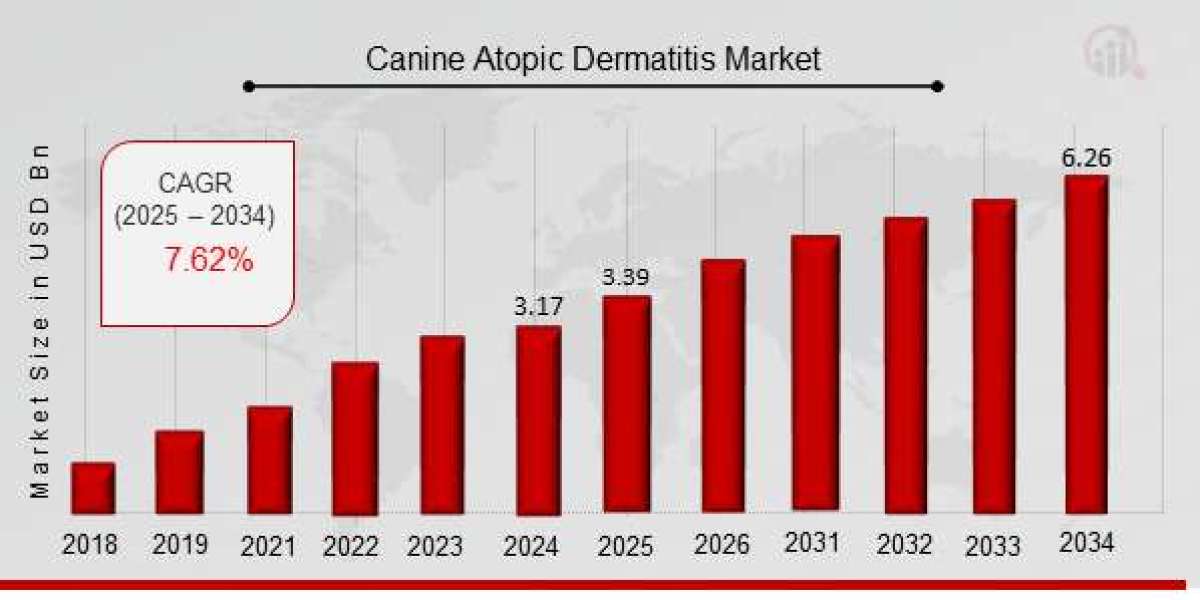Introduction
Canine atopic dermatitis (CAD) is a chronic skin condition affecting dogs, characterized by intense itching, inflammation, and recurrent skin infections. As pet owners become more conscious of their pets’ health, the demand for effective treatments and veterinary dermatological solutions has increased, driving the Canine Atopic Dermatitis Market.
With growing awareness about pet dermatology, advancements in veterinary medicine, and an increase in pet adoption rates, the market for canine atopic dermatitis treatments is expanding rapidly.
Understanding Canine Atopic Dermatitis
Canine atopic dermatitis is an allergic skin disease caused by an overactive immune response to environmental allergens such as pollen, dust mites, mold, and certain foods. It often manifests in dog breeds genetically predisposed to allergies, including Labrador Retrievers, Bulldogs, Golden Retrievers, and Terriers.
Symptoms of Canine Atopic Dermatitis
✔ Excessive scratching, licking, or biting of the skin
✔ Red, inflamed skin, often with lesions or sores
✔ Chronic ear infections
✔ Hair loss in affected areas
✔ Thickened or darkened skin over time
✔ Secondary bacterial or yeast infections due to skin barrier damage
Treatment Options Driving Market Growth
1. Anti-Inflammatory Medications
- Corticosteroids (such as prednisone) reduce inflammation and itching.
- Non-steroidal drugs like Oclacitinib (Apoquel) and Lokivetmab (Cytopoint) target specific inflammatory pathways, reducing symptoms with fewer side effects.
2. Topical Therapies and Medicated Shampoos
- Antifungal and antibacterial shampoos help prevent secondary infections.
- Moisturizers and barrier repair creams improve skin hydration and reduce irritation.
3. Immunotherapy (Allergy Shots)
- Allergen-specific immunotherapy (ASIT) desensitizes dogs to allergens over time.
- Considered a long-term solution for atopic dermatitis.
4. Nutritional and Dietary Management
- Omega-3 and Omega-6 fatty acids support skin health and reduce inflammation.
- Hypoallergenic diets help manage food-related allergies.
5. Biologic Therapies and Monoclonal Antibodies
- Monoclonal antibodies like Cytopoint offer long-lasting relief from itching without steroids.
Key Market Drivers
✔ Rising Pet Ownership and Spending on Pet Healthcare – Growing numbers of pet parents are willing to invest in high-quality veterinary treatments.
✔ Advancements in Veterinary Dermatology – New biologic drugs and targeted therapies have improved treatment outcomes.
✔ Increased Awareness Among Pet Owners – More pet owners recognize the importance of dermatological health, leading to early diagnosis and treatment.
✔ Growth in Veterinary Clinics and Pet Insurance – Expansion of specialized veterinary dermatology clinics and the rise of pet insurance coverage for chronic conditions support market growth.
Challenges in the Market
❌ High Cost of Treatment – Advanced therapies like monoclonal antibodies and immunotherapy can be expensive.
❌ Limited Access to Veterinary Dermatologists – Not all regions have specialized veterinary dermatologists, making treatment access difficult.
❌ Side Effects of Long-Term Medications – Steroids and immunosuppressants may cause side effects with prolonged use.
Canine Atopic Dermatitis Market Overview:
As per MRFR analysis, the Canine Atopic Dermatitis Market Size was estimated at 3.17 (USD Billion) in 2024. The Canine Atopic Dermatitis Market Industry is expected to grow from 3.39 (USD Billion) in 2025 to 6.26 (USD Billion) till 2034, at a CAGR (growth rate) is expected to be around 7.06% during the forecast period (2025 - 2034).
Emerging Trends & Future Outlook
? Growth of Veterinary Telemedicine – Online consultations for pet dermatology issues are increasing.
? Development of New Biologic Therapies – More targeted and less invasive treatments are in development.
? Increased Focus on Preventive Care – Pet owners are adopting allergen-free diets and skin health supplements to prevent flare-ups.
? Expansion of Pet Care E-Commerce – Online platforms are boosting sales of medicated shampoos, allergy supplements, and prescription treatments.
Final Thoughts
The Canine Atopic Dermatitis Market is set for continued growth, driven by rising pet care awareness, advancements in veterinary medicine, and innovative dermatological treatments. With further research into targeted biologics and holistic pet care solutions, the future looks promising for managing skin allergies in dogs.
For more information, please visit @marketresearchfuture
Explore Our Latest Reports
? Hemato Oncology Testing Market
? Ultrasound Needle Guides Market
? Veterinary Anesthesia Equipment Market
? Stay ahead in the healthcare industry. Browse our latest insights now!








